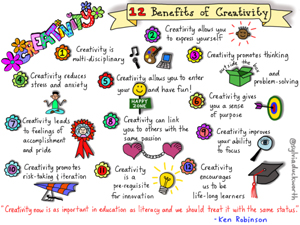 Online attendance registers. Email messages. YouTube videos. Cloud storage interfaces. Social media feeds.
Online attendance registers. Email messages. YouTube videos. Cloud storage interfaces. Social media feeds.
For digitally connected educators and students in schools with 1:1 device programs, this litany of screen-based daily tasks will be all too familiar. Any learning strategy that taps into the four C's of 21st-century learning while also enabling learners some screen-free time is highly enticing. Enter “sketchnoting," or purposeful doodling.
In her 2011 TED Talk, Doodlers, Unite!, Sunni Brown recasts the humble doodler from a time-wasting dreamer to a focused and reflective learner. Brown argues that of the four ways that learners take in information—visual, auditory, reading and writing, and kinesthetic—deliberate doodling engages all modalities simultaneously, leading to a deeper understanding of new information. Given the propensity of some students to doodle rather than to write notes, especially during direct instruction, the idea that this behavior can be harnessed to leverage, rather than to distract from, learning is most welcome. According to a 2014 study in Psychological Science, students who take notes by hand are more likely to develop greater conceptual understanding and retention of new information than students who take notes using a laptop.
Fortunately, there exists a community of educators who have long known the power of representing learning through sketchnoting, visual note-taking, and graphic recording. Sylvia Duckworth, Mike Rohdes, and Doug Neill have all published books, websites, videos, and online courses for educators to help students use drawing and illustration to demonstrate understanding.
Recently I attended an EdTechTeam Singapore Summit Featuring Google for Education, where Sylvia Duckworth was a featured presenter. She encouraged the delegates to see the value in sketchnoting to help students to “retain information, increase focus and engage in creative thinking.” As I sketched and doodled my way through the two-hour session, I planned this list of classroom activities to try with students in my English class:
In addition to these energizing classroom ideas, one of the best takeaways from the summit with Sylvia Duckworth was a spiral-bound A5 sized notebook. Written on the back and front cover of was an explicit, and highly confusing, warning: “Do not microwave this notebook.”
All summit attendees had been given a Rocketbook, which is a “cloud connected intelligent notebook.” The bottom of each page in a Rocketbook contains seven symbols which, when coupled with a free smartphone app, can be synced to a range of online locations. Users write or draw their notes on the paper, tick the symbol that represents the synced destination (email, Google Drive, Evernote, Dropbox, social media, etc.), and scan the page with their phone. The image is then cropped, enhanced, and "blasted" to its final location where it can be manipulated, stored, or shared with others. I had been issued the single-use version, Rocketbook One—not to be confused with the multi-use Rocketbook Wave, which enables users to erase the pages of the notebook using a cup of water and...a microwave oven!
This ingenious notebook is the perfect tool for anyone who wants to experiment with sketchnoting and share their work with a learning community. Rocketbook-ers enjoy screen-free time while creating their sketchnotes, then instantly store and share their finished products online in any number of digital forums.
Sketchnoting for school students with Rocketbook? Blast off!
 Nicole Timbrell is the head of digital learning and Australian curriculum coordinator in the Secondary School at the Australian International School Singapore, where she also teaches English. Formerly, Nicole was a graduate student and a research assistant at the New Literacies Research Lab at the University of Connecticut’s Neag School of Education.
Nicole Timbrell is the head of digital learning and Australian curriculum coordinator in the Secondary School at the Australian International School Singapore, where she also teaches English. Formerly, Nicole was a graduate student and a research assistant at the New Literacies Research Lab at the University of Connecticut’s Neag School of Education.
This article is part of a series from the International Literacy Association Technology in Literacy Education Special Interest Group (TILE-SIG).